Hi everybody! So the big Christie’s and Sotheby’s Magnificent Jewels auctions happened in New York last week, and to be honest I wasn’t blown away — but if you’ve followed me over the years, you already know I’m not a big diamond person. Honestly, I just think this is stupid:
It’s a 41.50 carat Type IIa round diamond and somebody spent $4.86 million for it at Sotheby’s on Thursday. It comes with a platinum ring mounting, and all I can think about is how silly that thing must look flopping around on a hand. It’s a ring pop! If you’re going to buy a stone that obnoxiously huge, at least go full eccentric and make a forehead diadem out of it.
But whatever, that’s just me. If you’re into it, ignore me and have a root through the auction catalogs linked above, because there’s plenty of big stuff to swoon over.
Also in the Sotheby’s sale is this circa 1890 carved moonstone and diamond brooch depicting three babies in bonnets. Sotheby’s notes that Tiffany & Co. sold brooches of this sort in the late 19th century, and while this one isn’t marked, it’s of Tiffany quality. They also say that:
Moonstone is meant to bring about good fortune and feelings of love. In addition, it is supposed to make the wearer more accepting of change, balance emotions, promote a calm mood, encourage peace and improve confidence. Any parent with three babies would certainly benefit from these effects, so the choice of moonstone for this cameo could not be more appropriate.
Which is a load of foofy nonsense, and that thing is an abomination.
I DO like this star tiara in the Christie’s sale, though. Circa 1890, it features cushion-cut amethysts and old and rose-cut diamonds set in silver-topped gold.
The biggest seller at Christie’s was this 2.17 carat fancy vivid purplish pink diamond ring. It’s shown unmounted here, but the stone is set in an 18k yellow gold and platinum band studded with round diamonds. It sold for $3.51 million, well over its high estimate of $2.5 million.
There are other Magnificent Jewels auctions still to come, with one at Sotheby’s Hong Kong on Tuesday and two more at the Geneva branches of Christie’s and Sotheby’s in May. I’ll look at the May auctions in a later newsletter, but there are some lovely things to point out in the Hong Kong sale tomorrow, including this jadeite bangle:
Jadeite is enormously popular in China — the GIA notes that “the character for jade is one of the oldest in written Chinese, dating to 2950 BC” — so it always takes pride of place in the Hong Kong auctions. Jadeite comes in a range of colors including white, lavender, orange and black, but the vivid emerald green shade — known as “imperial jade” — is the most desirable, and the two highest valued lots (so high the estimate is only “available upon request”) in the Sotheby’s auction are a vivid green bangle and bead necklace.
The jadeite bangle above is a pale celadon green shade that’s less desirable than that of imperial jade, but it exhibits what Sotheby’s calls a “glass-like translucency” that I think is absolutely GORGEOUS.
This Cartier platinum, emerald, seed pearl and diamond pendent necklace is also included in the Sotheby’s Hong Kong sale. Set with a giant 42.09 carat emerald bead, it features a diamond-crowned tassel incorporating individual strands of seed pearls, each one terminated with a brown-tinted diamond briolette. Another emerald is suspended from the clasp.
Last week, the online “Out of the Ordinary” auction at Sworders got a lot of chatter on Twitter thanks to a large array of sensational memorabilia, including Fiji mermaids, hoax Victorian child skeletons, and even an actual Dalek. The thing that jumped out at me the most, though, was this striking and unsettling poster for Die Hexen Von Salem, a joint French & East German film production of Arthur Miller’s 1953 play The Crucible. The 1957 film starred Simone Signoret and Yves Montand, and the screenplay was written by none other than Jean-Paul Sartre. Wikipedia says — unsourced — that Miller prevented the film from being widely distributed because he didn’t like what Sartre did with the script, but in an interview in the July/August 1972 issue of Audience Magazine, he’s actually pretty supportive. He definitely didn’t like Sartre’s angle:
Fundamentally, I thought that it was weakened and made less actual, rather than more pointed, by Sartre’s overly Marxist screenplay. Or maybe it is less a Marxist distortion than a European one.
…But he goes on to say he saw the “deeply moving and quite beautiful” film as more of a “version” of The Crucible, and one that was strong in its own right. So I dunno. Wikipedia also mentions further unsourced rumors that Miller’s suppression of the film was really because his wife, Marilyn Monroe, had an affair with Yves Montand after filming Let’s Make Love in 1960. I mean, it probably didn’t help.
This Cartier brooch is included in the Christie’s New York Jewels Online auction ending tomorrow. It depicts a diamond-set unicorn (with a sapphire collar) chained to a 14k gold fence and reclining under a tree laden with cabochon ruby pomegranates.
Christie’s doesn’t mention it, but the brooch is obviously inspired by “The Unicorn in Captivity,” the most famous of the Unicorn Tapestries, a series of seven wall hangings that currently reside at the Met Cloisters in New York. Dating to the late Middle Ages, the tapestries depict scenes from a unicorn hunt — although the Met speculates that the Unicorn in Captivity may have been an individual composition and not part of the series, as it’s replete with betrothal imagery:
In this instance, the unicorn probably represents the beloved tamed. He is tethered to a tree and constrained by a fence, but the chain is not secure and the fence is low enough to leap over: The unicorn could escape if he wished. Clearly, however, his confinement is a happy one, to which the ripe, seed-laden pomegranates in the tree — a medieval symbol of fertility and marriage — testify.
Happily, this piece gives me an excuse to link to this Paris Review article on the tapestries (and an obsessed Cloisters security guard) that was — at least for me — one of the few bright points of 2020.
There’s a Stage & Screen auction coming up at Doyle on the 28th that is very interesting — particularly if, like me, you’re nosy af and like to read dead people’s letters. The auction opens with 63 lots from the collection of Hollywood and Broadway actress Celeste Holm (1917–2012), including costumes, jewelry, awards and photos. Even better, there’s also loads of ephemera, including a letter from 20th Century-Fox chief Darryl Zanuck telling her how much weight he wants her to lose for her upcoming role in Gentleman's Agreement (1947), congratulatory telegrams celebrating her subsequent Oscar win for that role, and many letters of thanks documenting the charitable work she put in throughout her life for the Red Cross and the Actors Fund. There are also some delightfully chatty letters, including a thank you note from Phyllis Diller (“Dear darling sweet adorable old Celeste-baby”) and this early one from her good friend Richard Rodgers, regarding her pass on an offer to star in the 1948 theatrical tour of Annie Get Your Gun:
Dearest Chesty,
I write within an hour of the arrival of your letter for the sweet way in which you managed to say “no”. Believe me, Toots, we understand what you have in mind. Your career is actually just beginning and I know these things have to be planned like a war. If “Annie” isn't a logical part of the campaign, it should be discarded without a second thought. The other thing I know is that you gave it quite careful thought anyway and that the refusal wasn’t whimsical. However, of [sic] you think we won’t get together some day again, you’re crazy.
Chesty!?!
The jewelry selection is pretty sparse, but above is a personalized Cartier compact in silver, with the words “His and Hers” engraved on the back in honor of her 1954 starring role in the Broadway play.
(I also like this gold charm depicting a tiny hat in 14k gold with pearls and a single diamond accent. The piece opens to reveal an even tinier top hat stored inside, and is engraved on the back with the words “Millinery Institute of America Golden Hat Award to Celeste Holm 1959.”)
Mosheh Oved (1885-1958) was a Jewish antique jewelry and cameo dealer who came to London from Poland in 1902, when he was just 17 years old. Originally a watchmaker, he joined the antique jewelry trade and eventually opened a shop called “Cameo Corner” near the British Museum in Bloomsbury. He was a colorful and charismatic figure, and entertained an exclusive clientele including Queen Mary and, as the Classical Art Research Centre at the University of Oxford surmises, John Ringling of Ringling Brothers fame. You can actually get a teasingly small glimpse into his treasure trove of a shop in this “Jewels Down The Years” newsreel from 1945.
Oved also designed and made his own jewelry, and the story goes that he first stumbled into the practice during the London Blitz: While he and his wife sheltered in the basement of his shop, he began to play with some modeling wax to calm his shaking hands. He wound up creating a charming little ring in the shape of a lamb, and later went on to add other animals to his menagerie — including the rare and adorable lion above, which is featured in the April 28th London Jewels auction at Bonhams. Circa 1945-50, it’s made of hammered silver with a gold mane.
As usual, I’ve run out of space, so it’s time to wrap this thing up. If you feel like defending the honor of stupidly huge diamonds, you’re welcome to reply to this email, find me on Twitter, or:
Have a good week, everybody! xxx
Thanks for reading, and if you haven’t already subscribed, sign up here:




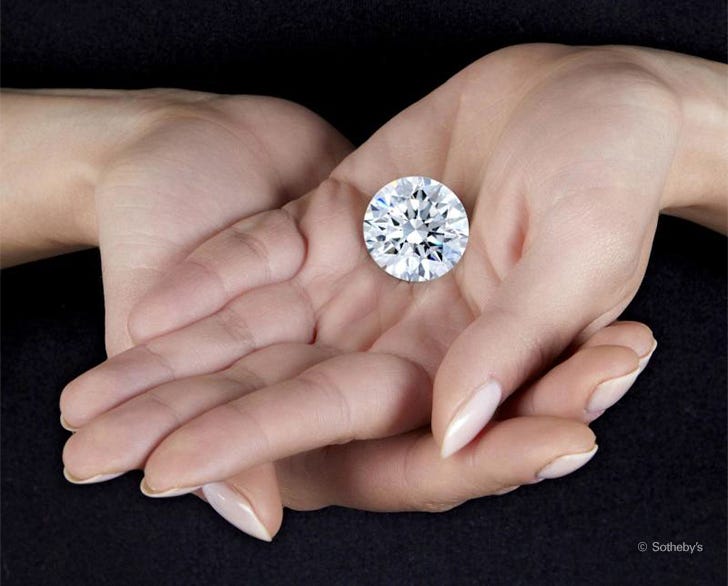
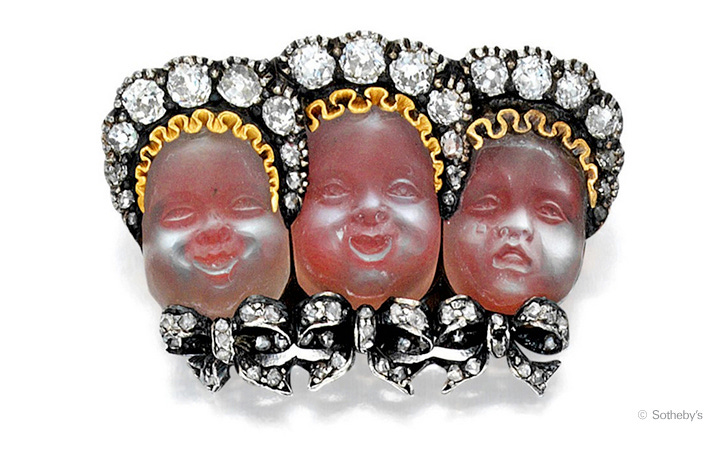
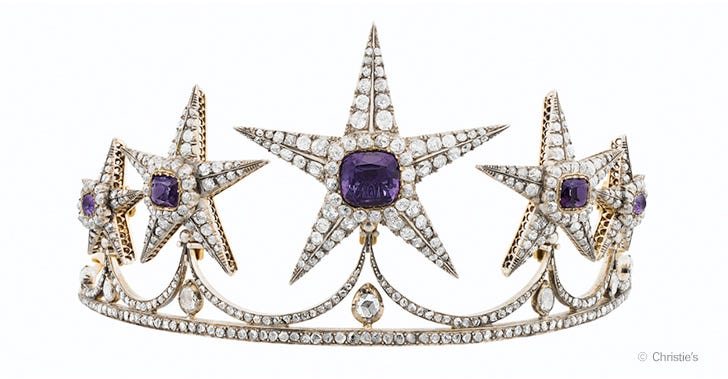
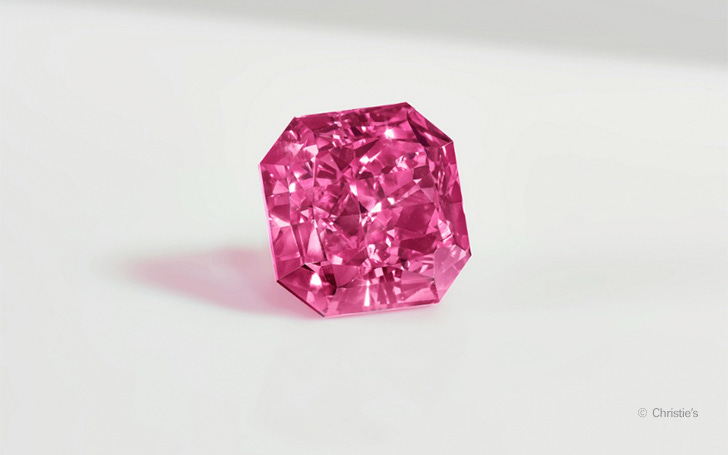
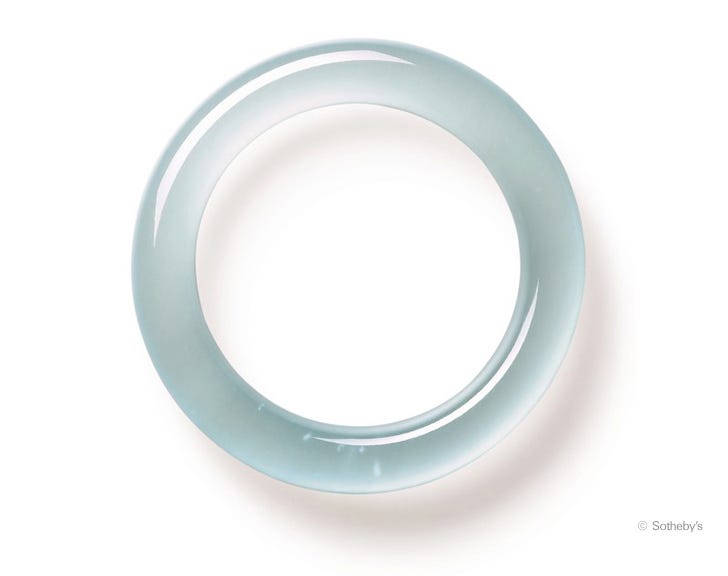
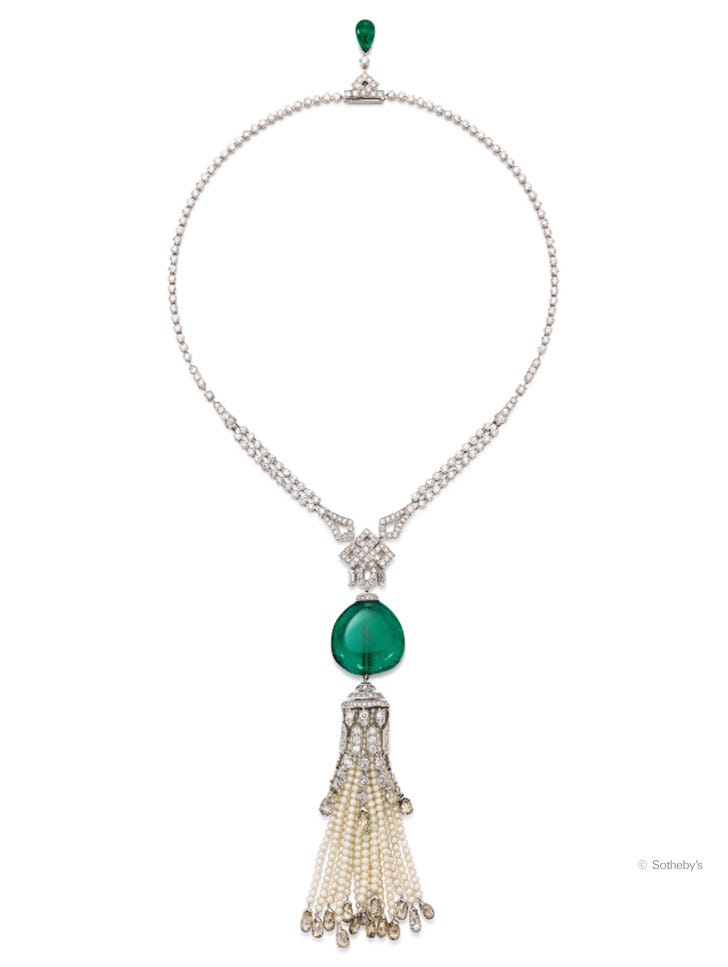

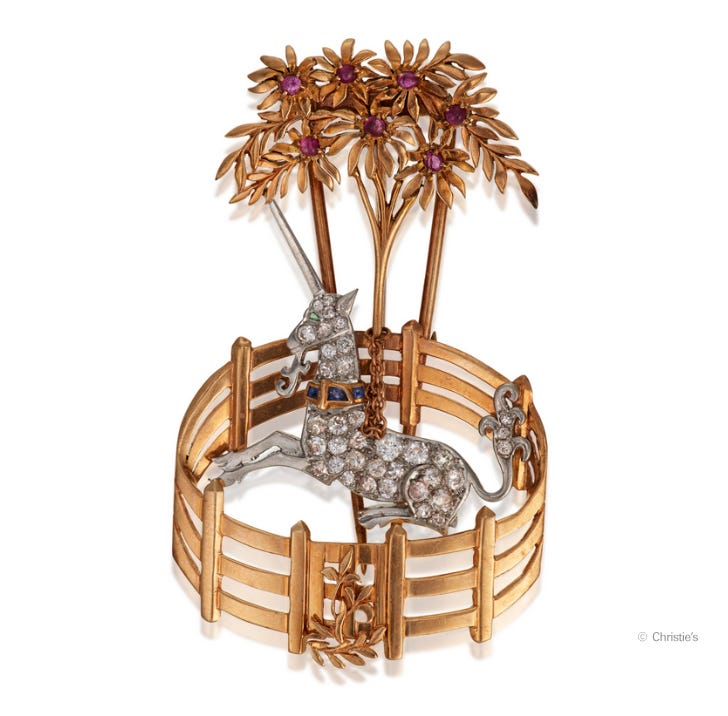

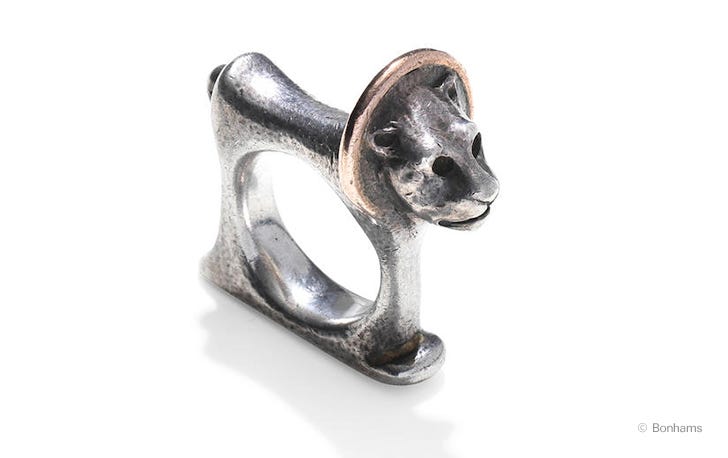
My husband wants to know what has my laughing hysterically. It’s your opinion of the baby heads brooch. I couldn’t agree more! And the “Out of the Ordinary”... I’ve muttered OMG at least 20 times. So amused!
Excited to see the three-baby brooch in my nightmares tonight lol!